
Are you experiencing chronic, unexplainable pain in your body? You could be dealing with Fibromyalgia and pain in Fibromyalgia trigger points. Fibromyalgia is a chronic condition that causes widespread pain in the body. It could present itself in several different ways, each one closely mimicking a host of other causes, making it difficult to diagnose. There is little known about the disease and some doctors do not even acknowledge its existence. Yet approximately 10 million people in the United States of America suffer from this condition.
This article will be going over the most common symptoms of Fibromyalgia and fibromyalgia trigger points, and suggest ways to relieve pain in those areas, culminating by describing a way to track your daily symptoms and evaluate the best course of action moving forward.[1][2][3]
A History of Fibromyalgia
Fibromyalgia trigger points (or tender points) were first discovered in the early 1820s. The doctors originally called the condition “Fibrositis”. The original cause of fibrositis was said to be inflammation at the sites of pain. It wasn’t until 1976 that the condition was renamed “Fibromyalgia”. “Fibro”, for Latin meaning fibrosis tissue”, “myo” and “algia” for Greek meaning muscle, and pain respectively. The new definition better described the symptoms ‑ muscle pain in fibrotic tissue.
The cause of fibromyalgia is still unknown many years later. However, we do know that it affects more adults than children and affects more women than men. Out of the 10 million Americans (as of 2021) affected, 90% of them are women. The current diagnostic criteria for Fibromyalgia are as follows:
- History of the three months of pain in six of nine general areas
- Moderate sleep disturbance
- Fatigue
Note: Although Fibromyalgia is generally grouped with arthritic pain it is not a type of arthritis. While some symptoms are similar – fatigue, depression and anxiety – the pain presents in very different ways. Arthritis causes the swelling and tenderness of your joints and is often found in your hands and feet. Fibromyalgia, on the other hand, causes sharp pain in trigger points in the muscles and tends to be widespread.[4][5]
The Most Common Symptoms of Fibromyalgia
The main symptom of Fibromyalgia is debilitating pain radiating from the top of a person’s head to the soles of their feet. The chronic pain will persist in certain areas called “Fibromyalgia trigger points” which will be defined in the next section. For now, here is a list of other common symptoms people diagnosed with Fibromyalgia present with:
- Fatigue
- Trouble sleeping
- Headaches
- Depression
- Anxiety
- Sensitivity to touch
- Fibro fog (foggy brain)
- Digestive Issues
- Lower than normal pain tolerance
- Irritable Bowel Syndrome
The Most Common Fibromyalgia Trigger Points
There are 18 trigger points associated with Fibromyalgia. Originally doctors would only diagnose someone with Fibromyalgia if they tested positive for pain in 11 of those 18 trigger points. However, as of 2016, a doctor can diagnose a patient if they test positive in a minimum of four of the trigger points. While Fibromyalgia trigger points are no longer used for diagnostic purposes, they are a good indication to get checked out by a doctor, sooner rather than later.
What is a Trigger Point?
Before we name the Fibromyalgia trigger points, let’s define what a trigger point is. A trigger point is described as a tender spot on the body that will produce localized pain if a doctor were to press on it with force. It is about the size of a penny. It is only considered a ‘point’ if the exact spot is pressed, and nothing else was to hurt. A major symptom to note is that the pain in Fibromyalgia trigger points fluctuates. The pain may vary in intensity from day to day, so do not ignore the pain if it seemingly disappears.
What is a Cluster?
Fibromyalgia trigger points also generally present in clusters on both sides of the body. In this case, a cluster is defined as several points of pain in a demarcated area. There are six clusters spanning the length of the body:
- Neck
- Chest
- Shoulders
- Elbows
- Hips
- Knees
Listing the Fibromyalgia Trigger Points
Now let’s list the nine most common Fibromyalgia trigger points. Note these trigger points appear in both the front and back of the body – for more clarification, refer to the image inserted on the right-hand side of the page. The red dots indicate the exact spots where a person feels acute pain.
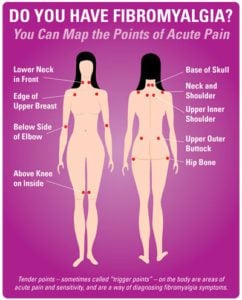
Front of the Body
- Lower neck in front
- Edge of upper breast
- Below the side bone at the elbow
- Slightly above the knee on the inside
- Base of skull
- Neck and shoulders
- Upper inner shoulder
- Upper outer buttock
- Hip bone
While most symptoms listed are common to men and women, men more commonly suffer from morning stiffness, and only women can experience Dysmenorrhea (pain with menstrual cramps).
If you feel like the symptoms, in conjunction with the trigger points listed, fit what your body is experiencing, please make an appointment with your doctor immediately. As mentioned before, Fibromyalgia is still a very poorly understood condition so do not get disheartened if your doctor does not agree with your diagnosis It takes, on average, more than 2 years to be correctly diagnosed with Fibromyalgia. To get the fastest and most accurate results to talk to a specialist like a rheumatologist who has had experience with the condition on prior occasions.
What Makes Fibromyalgia Trigger Points Worse?
It is important to remember things to avoid as much as possible so as not to make the Fibromyalgia trigger point pain worse. Although many of the things listed are not completely in our control, we can try to minimize the effect of these illnesses on our minds and body.
- Anxiety
- Depression
- Fatigue
- Infections
- Lack of sleep
- Emotional distress
- Physical exhaustion
- Sedentary lifestyle
- Hormonal changes
Are There Some Ways to Help Alleviate the Pain?
There are many ways to temporarily alleviate Fibromyalgia pain. People afflicted with Fibromyalgia have suggested remedies ranging from medication to lifestyle changes.
Medication
The United States Food and Drug Administration (FDA) has currently approved three medicines to help treat Fibromyalgia:
- Duloxetine (Cymbalta)
- Milnacipran (Savella)
- Pregabalin (Lyrica)
Note: These medications are not available over the counter (OTC). You must only take them after consulting with your doctor and if he/ she prescribes you the medication. Some people have also said they are able to manage their pain with ibuprofen or acetaminophen. Again, please consult a doctor for appropriate use and dosage.
Non-Medication Remedies
To target the Fibromyalgia trigger points specifically, there are several things you can try that do not require you to take medication.
- Massage therapy
- Chiropractic care
- Acupuncture
- Non-strenuous exercises (such as swimming or tai chi)
- Heat packs or warm towels on trigger points
- Warm showers
Lifestyle Changes
For more long-term lifestyle changes you should try and de-stress more often and get more rest. Deep breathing can help relax your mind and muscles. Getting more rest will allow your body to repair itself, take pressure off your back and bring relief to the trigger points. Finally, being more active and regularly exercising will keep your muscles limber and can reduce aching.
Mood Disorder and Emotional Distress Remedies
The anxiety, depression, and emotional distress caused by medical illness are far more complicated than the article could hope to sufficiently discuss. However, taking the following steps may help. Talking to a therapist is the most commonly cited remedy. However, there are many other remedies you can try to get some relief.
Journaling, mood tracking, and symptom tracking are three of the most widely used solutions. They bring self-awareness to your mental state and prevent emotions or stress from piling up and overwhelming you. Below is a guide to help you get started on your journey toward giving these antidotes a try.[15][16][17][18][19]
A Guide to Journaling, Mood Tracking, and Symptom Tracking
Journaling
Journaling is the act of writing down one’s thoughts. If you have never journaled before not worry. Here are a few suggestions on what to write about to get you started.
- Start small – put pen to paper, or phone to hand and start writing whatever comes to mind
- Use your journal in the morning to set goals for the day and then again at night to review how far you got in achieving those goals
- Evaluate your thoughts, feelings, and emotions at the end of every day and track any improvements you may see to your mental and physical health
Remember a journal can be used to keep track of anything; be it mental health, physical health, goals, and the list goes on. Keeping a daily track of any number of these topics will help alleviate some of the pressure you feel. This in turn could have a positive effect on the pain you feel in your fibromyalgia trigger points as you start to destress.
Mood Tracking
Mood tracking can help keep track of your mood and mood changes at regular intervals. Tracking helps identify patterns over time and in different situations. This is of great help when dealing with depression and anxiety, to help regulate note and regulate triggers those changes. Currently, the most popular method of mood tracking is to use an app on your phone. Some tips for mood tracking are:
- Be honest – track both your positive and negative emotions to get an accurate representation of your mood changes
- Check at regular intervals – pick times of the day that you will record your mood and do it every single day for a period. By staying consistent you will be able to see emerging patterns and make appropriate changes to your life.
Symptom Tracking
Like mood tracking, symptom tracking allows you to see emerging patterns. For example, when women get their periods, it is useful to track their symptoms every month to see what stays the same and what changes. The tracking allows them to be prepared for what to expect for the next month. It also helps to note any drastic changes and actions to avoid that negatively affect symptoms.
A unique feature to make note of is the ability to identify a lack of symptoms as well. For example, with a migraine, if you have light sensitivity one month and note it down, it is easy to notice if it does not affect you the same way the next time. This can help doctors change tweak prescriptions and plan more accurately, and at a faster pace.[20][21]
So Where to Find a Journal, Mood Tracker & Symptom Tracker All-In-One?
This is where CareClinic comes in. CareClinic has features including “diary entries” to note down what you are feeling, “factors” ranging from what kind of day you’re about to have to what kind of weather you are experiencing, and a “symptom tracker” to note any specific aches and pains.
You may be apprehensive about journaling, mood, or symptom tracking on an app you have never used before, but don’t worry, the next few sections will show you guides for each tracker. For convenience, there will also be visual screenshots of what the app looks like so you can follow along once you have downloaded the app from the App Store or on Google Play.[22][23]
Guides For CareClinic App Features

 Diary Entry
Diary Entry
The Diary Entry feature allows you to type up to 144 words per entry. There are options to “bold”, “italicize” or “underline” important words for future reference and add photos or pictures to each entry. The functionality of the actual diary is simple – type and save. The unique feature in the diary is the journal prompts button within the app. CareClinic allows a user to choose from three free prompts but become a premium member and that number increases to 11, ranging from “Acceptance” to “Values”.
On the left-hand side of the page are two images to show you what the features within the diary tab are.

 Factors (Mood Tracker)
Factors (Mood Tracker)
The “Factors” tab within the app gives you the ability to choose from multiple options or search for key phrases and words to describe their day. Ranging from topics such as general outlook, a specific feature for COVID under “Virus Risk Factors” to weather, this tab allows you to track what kind of day you have had and reflect on what could be done differently to create a better outcome.
The app gives a limited number of pre-programmed options on the homepage, but by clicking the “Add/Edit” button, you can choose from up to 18 new options, or search under “Add Factor” for any unseen topic. This mood tracker can help create links between circumstances and the impact it has on mood.

 Symptoms (Symptom Tracker)
Symptoms (Symptom Tracker)
With the Symptoms tab on the app, you can add whatever symptoms you would like to track ranging from headaches to sexual dysfunction.
When searching for a symptom, the tracker will ask when the symptom first started – it could be years ago. The page will then ask to link to an “Existing Care Plan”. The page then asks for “Notes” and “Frequency” of symptoms – how many days a week and how many times a day.
You can even add a reminder for the app to prompt how you are feeling as often as you’d like. Every day the app will then ask the severity of the symptom being tracked on a 10-point scale and allow for additional notes to be added. The two images on the right-hand side of the page create a visual to better understand this process.

 Care Plans
Care Plans
Another benefit of using the CareClinic app is the ability to form custom care plans. The care plan allows you to add all the relevant trackers in one place. As a user, you can add treatments at any time. This will help you keep track of medication your doctor may prescribe. Within the care plan, you can set reminders on when to take the medication every day and start to build patterns on mood affectation, pain relief etc.
Similarly, the care plan also encourages you to add symptom and measurement reminders, so the app can remind you to record them daily. This daily exercise will allow you to identify patterns or causes of concern faster than if you did not track your symptoms. This tracking could then facilitate a conversation with you and your doctor to adapt the treatment plan that best suits your needs.
Conclusion
In conclusion, to all the readers if you think you could have Fibromyalgia and you are experiencing the Fibromyalgia trigger points, go see a doctor. You should also download the CareClinic app here to start tracking and building better outcomes for yourself. By starting to track your symptoms early, you could get diagnosed at a faster rate. Leveraging the information, tips and guides in this article helps make your life a little easier if suffering from this ailment.
References
- “Challenges of Pain in Fibromyalgia”. https://practicalneurology.com/diseases-diagnoses/headache-pain/challenges-of-pain-in-fibromyalgia/31785/
- “Fibromyalgia Facts and Statistics”. https://www.ncoa.org/adviser/sleep/fibromyalgia-facts-and-statistics/
- “Fibromyalgia | AAFP”. https://www.aafp.org/pubs/afp/issues/2007/0715/p247.html
- “FMA UK – The History of Fibromyalgia”. https://www.fmauk.org/latest-news-mainmenu-2/articles-1/1388-the-history-of-fibromyalgia
- “Fibromyalgia – Endotext – NCBI Bookshelf”. https://www.ncbi.nlm.nih.gov/books/NBK279092/
- “What is Fibromyalgia? – Symptoms & Treatment | NIAMS”. https://www.niams.nih.gov/health-topics/fibromyalgia
- “Fibromyalgia | Arthritis | CDC”. https://www.cdc.gov/arthritis/fibromyalgia/index.html
- “”. https://www.nhs.uk/conditions/fibromyalgia/symptoms/
- “Fibromyalgia: Causes and Symptoms – NatureWord”. https://www.natureword.com/fibromyalgia-causes-and-symptoms/
- “What Triggers Fibromyalgia?”. https://carespace.health/post/what-triggers-fibromyalgia/
- “Fibromyalgia”. https://en.wikipedia.org/wiki/Fibromyalgia
- “How to Avoid Five Fibromyalgia Triggers”. https://www.upperspineknox.com/how-to-avoid-five-fibromyalgia-triggers/
- “How Can You Prevent Fibromyalgia? | Effective Strategies”. https://wellwisp.com/how-can-you-prevent-fibromyalgia/
- “Tackling 15 Common Fibromyalgia Triggers – Flipbook by 55427 | FlipHTML5”. https://fliphtml5.com/ulyd/qhlh/Tackling_15_Common_Fibromyalgia_Triggers/
- “Why Tai Chi Works So Well For Pain Relief”. https://time.com/5209233/tai-chi-chronic-pain/
- “Mind and Body Practices for Fibromyalgia: What the Science Says | NCCIH”. https://www.nccih.nih.gov/health/providers/digest/mind-and-body-practices-for-fibromyalgia-science
- “10 Natural Remedies for Fibromyalgia”. https://www.aarp.org/health/healthy-living/fibromyalgia-natural-remedies/
- “Non-Drug Treatments for Pain: Nine Strategies | ME/CFS & Fibromyalgia Self-Help”. https://www.cfsselfhelp.org/library/non-drug-treatments-pain-nine-strategies
- “Fibromyalgia Treatment Options: A Comprehensive Guide – Livingwithfibromyalgia.org”. https://livingwithfibromyalgia.org/fibromyalgia-treatment-options/
- “The Power of Journaling: What Science Says About the Benefits for Mental Health and Well-Being – Child Mind Institute”. https://childmind.org/blog/the-power-of-journaling/
- “Why Journaling Is Good For Your Health | Piedmont Healthcare”. https://www.piedmont.org/living-real-change/why-journaling-is-good-for-your-health
- “Symptom & Mood Tracker – Apps on Google Play”. https://play.google.com/store/apps/details
- “Tracker, Reminder – CareClinic on the App Store”. https://apps.apple.com/us/app/tracker-reminder-careclinic/id1455648231


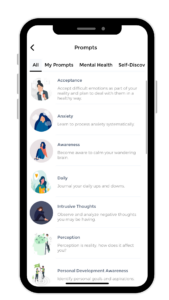
 Diary Entry
Diary Entry
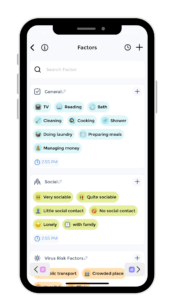 Factors (Mood Tracker)
Factors (Mood Tracker)
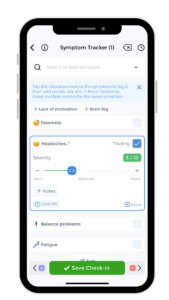 Symptoms (Symptom Tracker)
Symptoms (Symptom Tracker)
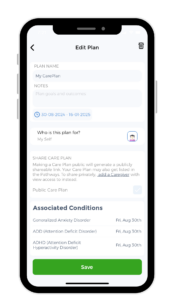 Care Plans
Care Plans